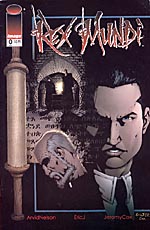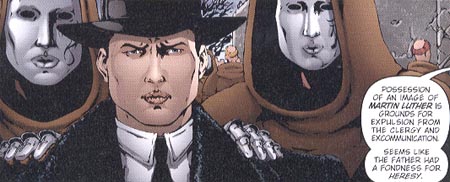 Written by Arvid Nelson
Written by Arvid Nelson
Art by Eric Johnson
32 pages, color
Published by Image Comics
It’s fun to think, “What if…?” with world history. What if things went slightly differently? What if the church had never lost its power? What if America ended up being permanently divided into two countries? What if sorcery existed as a tangible force in society? What sets Rex Mundi apart from other books, then, is that it’s not content to simply gaze at an alternate history of the world. Instead, it’s just the backdrop for an even bigger story…
Doctor Julien Saunière was summoned by an old friend, Father Gérard Marin, to locate a missing scroll that was stolen from a vault under a church in Paris. Julien’s about to discover that the path of this scroll, though, is one that moves frequently through death, as people seem to be dying almost faster than Julien can discover the clues. When even the church seems displeased at Julien’s search, Julien’s only remaining ally is Doctor Genevieve Tournon. And when you realize that Genevieve is Julien’s former lover that has long since moved on, you know that things are definitely not looking good.
Arvid Nelson’s story in Rex Mundi impressed me at an initial glance because it did such a good job of creating a world that was both similar and different to the one that we live in. This 1933 is more dangerous, more rich in possibility, and there must have certainly been a temptation to simply stop and linger over the details. What’s nice, though, is once you’re past the initial glance you see that Nelson’s story keeps moving forward, letting the setting play its part even as the main action continues. In just four issues there were a lot of nice little twists that I didn’t see coming; Rex Mundi doesn’t play it safe, and rewards the reader with a genuine mystery to be solved that has equally high stakes for anyone daring to venture too close. Julien and Genevieve are a nice match for each other, and it’s a relief to see that two diametrically different people don’t fall into the easy trap of “good” and “bad”; they’ve both got their pluses and minuses. In other worlds, just like the real world.

The art in Rex Mundi is important because the reader needs to know at just a glance that we’re not in the present day, that we’re somewhere very different indeed. Eric Johnson succeeds, bringing the world of 1933 Paris to life with apparent ease. The fashions of the time look very natural on his characters, and Johnson has clearly made sure to use a lot of appropriate reference material to get the look of the city just right. Maybe my favorite thing about the book, though, is how Johnson draws faces. It sounds silly, but when most artists try to draw the natural wrinkles and shadows that exist on people’s faces, it just makes them look like they’re 120 years old. That’s not the case here; Johnson does a great job at making his people look realistic, and it’s just one aspect out of many that works. (Extra kudos also go to bringing colorist Jeromy Cox, easily one of the best in the business.)
It wasn’t until pretty recently that I realized I’d never actually reviewed Rex Mundi; it’s such a familiar enjoyment that it just seemed natural that I’d already sung its praises. With four issues (including a #0) available, it’s not too late to jump on board and see for yourself, especially with Rex Mundi #4 scheduled to hit stores on June 25th. Need more convincing? You can read all of Rex Mundi #0 online at the Image Comics website. Now that’s confidence in one’s creation. Rex Mundi is an ongoing series from Image Comics, and is on sale at better comic book stores everywhere.
